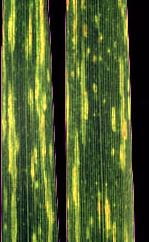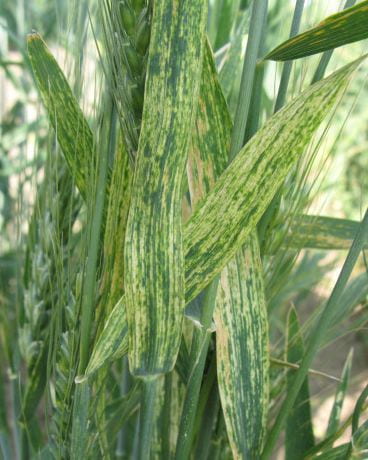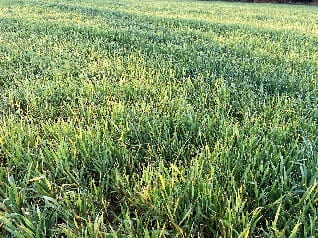Alyssa Koehler, Extension Field Crops Pathologist; akoehler@udel.edu
Effects of frost on small grains can vary greatly based on growth stage, length of exposure, temperature, and other factors. It will often take 3-4 days for symptoms to become visible, so we are now seeing the effects of the 2 nights of frost at the end of last week. Leaf tip necrosis, leaf yellowing, or leaf spotting from frost response can look very similar to a number of diseases. While lab confirmation is often needed to 100% guarantee a diagnosis, there are context clues that we can use to help narrow down options. I have created the chart below to help sort out symptoms that might be from disease or something abiotic like a frost event.
Wheat Soilborne Mosaic Virus

Wheat Soilborne Mosaic Virus, A Koehler, University of Delaware
Time of infection: Primarily fall, vectored by protozoan Polymyxa graminis.
Symptoms: Stunting, leaves with chlorotic mosaic, irregular mottling, and streaking.
Time of symptom appearance: In spring after green up. Symptoms are not expressed on leaves that emerge after the average temperature is above 68°F. (If your wheat has looked healthy up until the past few days, you are probably not looking at WSBM.)
Field Distribution/Location on Plant: Irregular, chlorotic patches in the field (often following low-lying wet areas favored by P. graminis). Movement in the plant is dependent on temperature. High temperatures limit movement into developing leaves.
Management: Planting resistant cultivars is the most economical management approach. P. graminis can survive in soils for many years.
Wheat Spindle Streak Mosaic Virus

Wheat Spindle Streak Mosaic Virus, https://www.apsnet.org/edcenter/disandpath/viral/pdlessons/Pages/SoilborneWheatMosaic.aspx
Time of infection: Primarily fall, presumed to be vectored by protozoan Polymyxa graminis.
Symptoms: Chlorotic streaks that are elongated and spindle-shaped, often with a dark green island in the center.
Time of symptom appearance: In spring after green up. Symptoms most severe following a cold winter. (If your wheat has looked healthy up until the past few days, you are probably not looking at WSSMV.)
Field Distribution/Location on Plant: Symptoms initially uniform across the field, but fade as temperatures warm.
Management: Planting resistant cultivars is the most economical management approach. P. graminis can survive in soils for many years.
Wheat Streak Mosaic Virus

Wheat Streak Mosaic Virus, https://cropprotectionnetwork.org/encyclopedia/wheat-streak-mosaic-high-plains-disease-and-triticum-mosaic-of-wheat
Time of infection: Primarily early fall, vectored by the wheat curl mite.
Symptoms: Rolled and trapped leaves are indicators of mite populations. Young leaves show yellow mosaic pattern of parallel discontinuous streaks. Yellowing can occur on the whole leaf.
Time of symptom appearance: Cool springs will delay the onset of symptom appearance, while an early, warm spring will maximizes impact to plants. Symptoms can be observed from tilling through ripening.
Field Distribution/Location on Plant: The margins of the field are often the first affected. Symptoms vary by cultivar, strain of virus, time of infection, and environment. Symptoms are often most severe on oldest leaves, with youngest leaves showing most characteristic mosaic symptoms.
Management: Management is focused on cultural practices to limit mite infestations. Destruction of volunteer wheat, later planting date, and avoiding susceptible alternative crops may help lower mite populations.
Barley Yellow Dwarf Virus

Barley Yellow Dwarf Virus, A Koehler, University of Delaware
Time of infection: Primarily fall, by aphid vectors. Spring infection can occur but is not usually as severe.
Symptoms: Leaf discoloration, particularly of flag leaves, that could be yellow, orange, red, purple, or brown and necrotic. Shortened internodes may result in shorter plants.
Time of symptom appearance: Typically becomes most apparent after flag leaves have emerged.
Field Distribution/Location on Plant: Yellowing/purpling of flag leaf tips is usually in scattered spots throughout the field.
Management: Adjusting planting to avoid peak aphid populations can help lower disease development the following spring. Treated seed may help to manage aphids.
Bacterial Streak and Black Chaff

Bacterial Streak and Black Chaff, Mary Burrows, Montana State University, Bugwood.org
Time of infection: Seedborne, seed is the most common primary inoculum source.
Symptoms: Water-soaked lesions extending along the leaf margins and midrib. When held up to light, lesions appear translucent. Lesions will turn yellow and eventually brown and necrotic. (Can be easily confused with Septoria tritici blotch.)
Time of symptom appearance: Leaf symptoms become most noticeable after heading. Symptoms on the head include black, longitudinal stripes on the glumes and purple-black lesions on the peduncle and rachis.
Field Distribution/Location on Plant: After heading a large number of lesions will appear suddenly on the upper leaves without noticeable progression from lower leaves. Lesions tend to be more abundant where dew remains at the bend of the leaf.
Management: Pathogen is primarily seedborne. Seeds can be tested to determine level of infestation, but no commercial seed treatment is available.
Spring Freeze Injury

Spring Freeze Injury, A Koehler, University of Delaware
Time of infection: n/a
Symptoms: Wheat is most sensitive to freeze injury during reproductive growth. Damage is often worse on leaf tips and newer leaves. Leaf chlorosis, burning of leaf tips, heads trapped in boot, floret sterility, white awns or heads.
Time of symptom appearance: Effects of freeze injury usually become visible 3-4 days after the freeze event.
Field Distribution/Location on Plant: Widespread across the whole field. Yellowing may occur primarily in low areas indicating freeze injury where cold air settled.
Management: Later maturing varieties may have a better chance of avoiding frost events.
Physiological Leaf Spots

Physiological Leaf Spots, A Koehler, University of Delaware
Time of infection: n/a
Symptoms: Leaf spotting not attributed to a biological pathogen.
Time of symptom appearance: Timing can vary based on contributing factors. Environmental stress, mineral imbalances, resistance gene reactions to rust fungi, aerial drift of fine droplets of nonselective herbicides, and other factors could lead to physiological leaf spots.
Field Distribution/Location on Plant: Usually present across the whole field. May vary by variety, particularly for resistance gene responses.
Management: n/a
Nutrient Deficiency

Nutrient Deficiency, Chloride deficiency symptoms https://webapp.agron.ksu.edu/agr_social/m_eu_article.throck?article_id=2133
Time of infection: n/a
Symptoms: Yellowing in lower leaves may indicate N deficiency. Whole plant yellowing may indicate sulfur deficiency. Chloride and Zinc deficiency may produce a “physiological leaf spot” symptom.
Time of symptom appearance: May vary depending on nutrient involved. Warm temperatures followed by cooler temperatures can slow nutrient uptake and may trigger deficiency symptoms in springs with temperature swings.
Field Distribution/Location on Plant: Whole fields may be affected but might vary based on soil type or fertilizer application pattern.
Management: Stay aware of field nutrient levels and soil pH and make applications as needed.
Heat/Drought Stress

Heat/Drought Stress, A Koehler, University of Delaware
Time of infection: n/a
Symptoms: May see reduction in biomass, yield, and grain quality.
Time of symptom appearance: Most sensitive at flowering through grain development stages.
Field Distribution/Location on Plant: Whole field.
Management: Irrigate if possible. Try to limit irrigation during heading to reduce risk of FHB.
